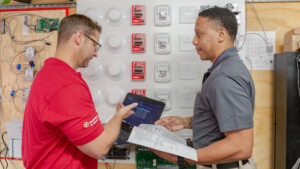
If you own or manage a commercial property, it is important to know as much as you can about your fire alarm system.
Fire alarm systems are everywhere. Every business, apartment, hospital, hotel, and school building has one. Yet, many people are unaware of inspection and testing requirements. Inspections and functional testing ensure that systems operate properly and remain code compliant. If you own or manage a commercial property, it is important to know as much as you can about your fire alarm system. Read on to learn all about the fire alarm inspection and testing process.
What Exactly is Fire Alarm System Testing?
Fire alarm system inspection and testing are related but not the same thing basically thing. Visual inspections focus on identifying damaged system devices and normal/off-normal indication lights or messages. Testing is the functional operation of system components. This is required by the National Fire Protection Association (NFPA) Standard 72 and has been adopted as law by most jurisdictions. Fire Marshals generally require this to be performed by professionally licensed companies, like Fireline.
This includes:
- Initiating Devices: Heat detectors, Smoke detectors, Beam detectors, and manual pull stations
- Notification Appliances: Horns, Horn/ strobes, Bells and Multi-media mass communications devices.
- Sprinkler devices that signal the fire alarm systems such as water flow devices and valve tamper switches.
- Fire Alarm Panels and Batteries.
- Monitoring system to ensure all signals are being properly transmitted to a UL listed Central Station.
These regular tests will ensure each component of your fire alarm system is in proper working condition.
Which Tests or Inspections are Required?
There are various required tests or inspections that fire alarm systems have to undergo. While many are familiar with annual inspection and testing where technicians test the initiating devices, fire alarm panels, and notification appliances to ensure that they’re operating correctly, here are two other tests that you might not be too familiar with:
Acceptance Testing: The acceptance test is required after the installation of a new system. It is the same as a functional test and ensures that all new system components are installed correctly and operating properly. Each device within the system is tested. This may also be required after a major building renovation
Sensitivity Testing: This is a periodic test to ensure that smoke detectors are sensing smoke within the manufacturer’s sensitivity rating, making sure the detector will respond promptly in the event of a fire
How Long Does an Average Test Take?
How long an inspection will take depends on the size and type of the building and system. Small commercial buildings can be completed in a half-day. Larger commercial buildings will take longer, 1 or 2 days. Complicated facilities, like hospitals, hotels, and condominiums can take as much as 1 or 2 weeks, depending on logistics and tenant coordination.
Fire Protection Services from Fireline
Whether you need smoke detectors, fire extinguishers, or an automatic sprinkler system installed at your commercial property, Fireline has you covered. We have been protecting people and property from fire damage since 1947—and our experience shows in our excellent work! We are known for our superb customer service, our expertise, and our reliability. For more information on how we can help your residential or commercial property, visit us online or give us a call at (800) 553-3405. We are located in Baltimore, MD, with a second office in Leesburg, VA. For more fire safety tips, be sure to follow us on Facebook, Twitter, and LinkedIn.
